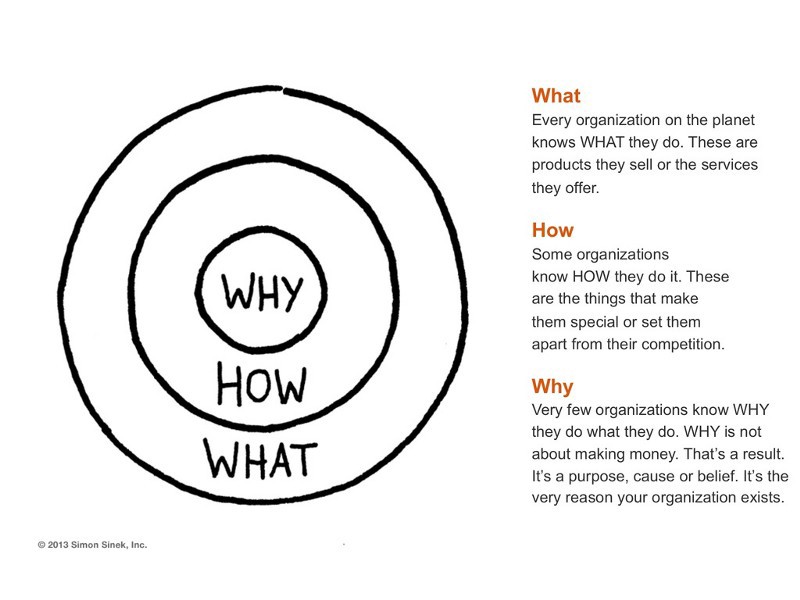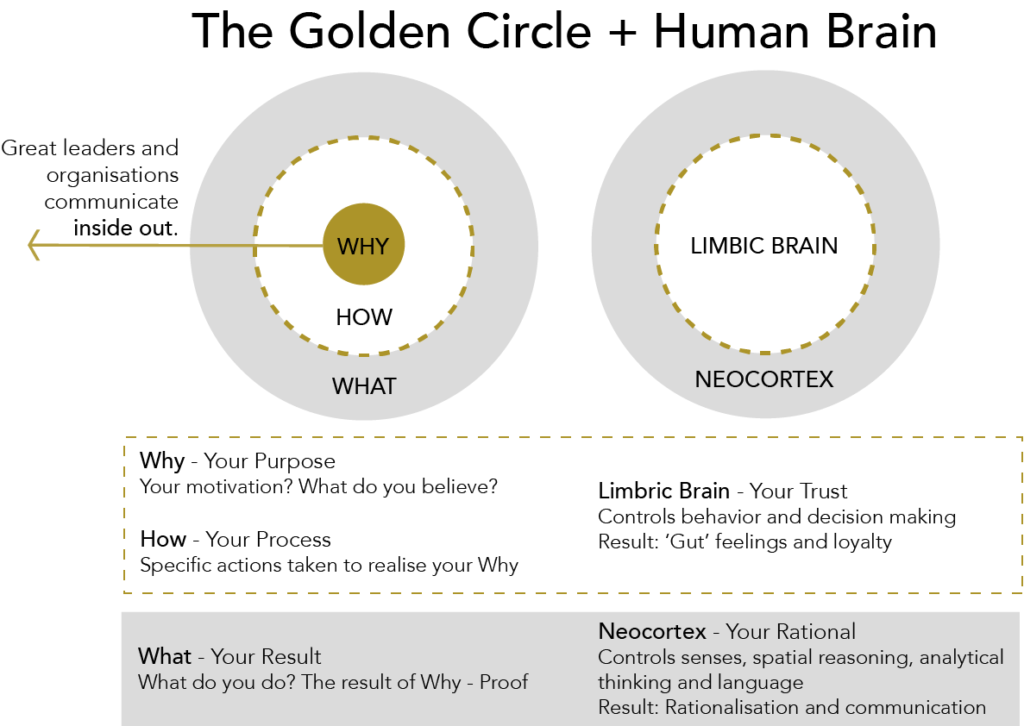
How great leaders inspire action หากเราวันนึงได้เป็นผู้นำ เราจะสามารถสร้างแรงบันดาลใจให้ผู้ตามได้อย่างไร? เพราะการเป็นผู้นำ เราต้องรับผิดชอบมากมายหลายด้าน ผลงานต่างๆ ก็ต้องขับเคลื่อนด้วยคน หากเราไม่สามารถสร้างแรงบันดาลใจ หรือ โน้มน้าวจิตใจให้คน หรือ ในที่นี้คือผู้ใต้บังคับบัญชาของเราได้ มันก็เป็นเรื่องยากที่จะประสบความสำเร็จ
รอบตัวเราหรือองค์กรที่เราทำงานอยู่ มักจะมีคนหลากหลายประเภทปะปนกันอยู่ หลายครั้งที่เราต้องรับคำสั่งมาให้ทำตามแล้วก็เกิดความขัดแย้งขึ้นในใจว่าสิ่งที่หัวหน้าสั่งมามันดูไม่ใช่สิ่งที่ถูกต้องเลย แต่เราก็ต้องจำทนฝืนใจทำไป แต่ในอีกเหตุการณ์นึง ทำไมกับบางคน ทั้งๆ ที่เขาอาจจะไม่ใช่คนที่มีอำนาจเหนือกว่าเราหรือไม่ใช่หัวหน้าเราด้วยซ้ำ เมื่อเขาเสนออะไร หรือขอให้เราทำอะไร เรากลับรู้สึกเห็นด้วยแล้วอยากช่วยและสนับสนุนพวกเขาอย่างเต็มที่ เรื่องนี้อาจจะเป็นคำตอบของความรู้สึกที่ว่าใช่หรือไม่ใช่ที่เกิดขึ้นในใจเราก็ได้
ทำไม (WHY), อย่างไร (HOW) และ อะไร (WHAT)
Simon Sinek นักเขียนผู้เป็นเจ้าของหนังสือ “Start with Why” เขาเล่าถึง Golden Circle หรือ วงกลมทองคำ วงกลมสามวงที่ซ้อนทับกันอยู่ นอกสุดคือคำถาม “อะไร” ชั้นที่ 2 คือ “อย่างไร” และในที่สุดคือ “ทำไม” เหมือนกับกระบวนการทั่วไปในการจะทำอะไรสักอย่าง เรามักถูกสอนให้คิดว่าเราจะทำอะไร? จะทำอย่างไร? และเราทำไปทำไม? แต่สำหรับ Simon เขาไม่ได้หมายถึงผลลัพธ์อย่างการทำกำไรหรือราคาหุ้นในตลาด แต่หมายถึงจุดประสงค์ เป้าหมาย หรือจุดมุ่งหมาย ที่ทำให้เราตื่นลืมตาขึ้นมาในทุกๆ เช้าแล้วยอมลุกขึ้นไปทำสิ่งเหล่านั้นอย่างไม่ลังเล

“องค์กรส่วนใหญ่มักเริ่มจากจุดที่ง่ายที่สุดเข้าหาจุดที่คลุมเครือที่สุด”
เพราะการตอบให้ได้ว่า ทำไปทำไม? เป็นสิ่งที่คลุมเครือและยากที่สุด คนหรือองค์กรส่วนใหญ่มักจะเริ่มจากการบอกว่าตัวเองจะทำอะไรแทน ยกตัวอย่างเช่น ถ้า APPLE เริ่มต้นจากการบอกว่าเขาจะผลิตคอมพิวเตอร์ ที่ใช้งานง่ายและมีดีไซน์ที่ล้ำเลิศ คำถามคือเราจะซื้อไหม? ขอให้พวกเราจำความรู้สึกนี้ไว้ก่อน นี่คือการตอบคำถามจากอะไร (WHAT) อย่างไร (HOW) ไปจนถึงทำไม (WHY)?
“ผู้นำและองค์กรที่ให้แรงบันดาลใจ จะเริ่มต้นจากสิ่งที่คลุมเครือที่สุดออกมาสิ่งที่ง่ายที่สุด”
ขอยกตัวอย่าง APPLE เขาเริ่มต้นจากการบอกว่าทุกอย่างที่เขาทำเป็นเพราะเขาเชื่อในการท้าทายสิ่งเก่าๆ และเชื่อในการคิดต่าง และด้วยความเชื่อนั้นเอง ทำให้เขาสามารถสร้างผลิตภัณฑ์ให้มีดีไซน์ที่สวยงามและใช้งานได้ง่าย มันคือคอมพิวเตอร์ที่ยอดเยี่ยมที่สุด ความรู้สึกมันต่างกันไหม เมื่อเปรียบเทียบกับวิธีการคิดที่เริ่มต้นด้วยคำถามว่าอะไร (WHAT)? แล้วเราอยากซื้อการนำเสนอรูปแบบนี้มากกว่าหรือเปล่า? นี่คือการตอบคำถามโดยเริ่มจากสิ่งที่ยากที่สุดอย่าง ทำไม (WHY)? ตามด้วยอย่างไร (HOW) และอะไร (WHAT)
“คนไม่ได้ซื้อเพราะสิ่งที่เราทำ แต่ที่คนซื้อเพราะเหตุผลที่เราทำ”
นี่คือเหตุผลที่ว่าทำไม APPLE ถึงประสบความสำเร็จ และคนไม่ได้ซื้อแค่คอมพิวเตอร์ของเขาเท่านั้น แต่คนยังซื้อโทรศัพท์ เครื่องเล่นเอ็ม MP3 IPAD และสินค้าอื่นๆ อีกด้วย ทั้งๆ ที่บริษัทคู่แข่งของพวกเขาในท้องตลาดก็มีสินค้าที่ไม่ได้มีความแตกต่างกันเลยในด้านของโครงสร้าง ความสวยงาม และคุณภาพ บางทีถ้าเอาสินค้าของ APPLE เทียบคุณสมบัติกับสินค้าของบริษัทคู่แข่ง เผลอๆ ของคู่แข่งอาจจะดีกว่าด้วยซ้ำในราคาที่เท่ากันหรือถูกกว่า ดังนั้นอยากให้เราลองเริ่มต้นด้วย ทำไม (WHY) เสียก่อน ส่วน อะไร (WHAT) คือ สิ่งที่อยู่เบื้องหลังการตอบคำถามโดยเริ่มจากทำไม (WHY) ที่ชัดเจนเสมอ
“มันไม่ใช่จิตวิทยาทางการตลาด แต่มันคือชีววิทยาเลยต่างหาก”
ถ้าเรามาลองดูภาพสมองของมนุษย์โดยดูจากมุมสูง เราจะเห็นว่าสมองของมนุษย์เราแบ่งออกเป็น 3 ส่วน ซึ่งสอดคล้องกับ Golden Circle หรือ วงกลมทองคำ สามส่วนพอดี สมองส่วนนีโอคอร์เท็กซ์ คือส่วนที่ตอบคำถามว่า “อะไร (WHAT)” สมองส่วนนี้ทำหน้าที่เกี่ยวกับเหตุผล การคิดวิเคราะห์และภาษา สมองส่วนกลาง 2 ส่วนเรียกว่าลิมบิก ทำหน้าที่เกี่ยวกับความรู้สึก พฤติกรรม และการตัดสินใจทั้งหมด แต่แย่หน่อยที่มันไม่มีศักยภาพด้านภาษาเลย

“ไม่รู้สิ แต่รู้สึกว่ามันยังไม่ใช่น่ะ”
การให้ข้อมูลว่า “เราจะทำอะไรก่อน” มันจะถูกส่งเข้าในสมองส่วนนีโอคอร์เท็กซ์ เพราะส่วนนี้เข้าใจภาษา คนรับสารจะเข้าใจว่าสิ่งที่เราทำคืออะไร? มีคุณสมบัติอย่างไร? ดีอย่างไร? แต่ความอยากทำจะไม่ได้เกิดขึ้น เพราะสมองส่วนที่มีผลต่อพฤติกรรมและการตัดสินใจคือลิมบิก และมันต้องการความรู้สึกที่เข้มข้นพอจะขับเคลื่อนพฤติกรรมให้ทำตามได้ หรือ ที่เราเรียกกันว่าแรงบันดาลใจนั่นเอง เพราะการให้แรงบันดาลใจ จะทำให้คนเกิดการตัดสินใจจากสัญชาตญาณมากขึ้น
“สูตรสำเร็จ = เงินที่มากพอ ล้อมรอบด้วยคนฉลาด และการตลาดที่ยอดเยี่ยม”
คนส่วนใหญ่รู้จักพี่น้องตระกูล Wright แต่ไม่รู้จัก Samuel Pierpont Langley ในตอนต้นศตวรรษที่ 20 Samuel มีสิ่งที่เราเชื่อว่าเป็นสูตรของความสำเร็จ เขามีเงินทุนสนับสนุนจากกรมการสงครามให้คิดเครื่องจักรกลที่บินได้ เขารู้จักคนเก่งๆ ทุกคนในยุคนั้น เขาว่าจ้างแต่คนระดับสุดยอดหัวกะทิให้เข้ามาร่วมทีมในการประดิษฐ์ครั้งนี้ด้วยจำนวนเงินที่สูงมากซึ่งได้มาจากเงินทุนที่เขาได้รับมา และสภาวะตลาดก็เยี่ยมมากในตอนนั้นและทุกคนติดตามเขาแทบทุกฝีก้าว แต่ทำไมในตอนนี้ ถึงไม่มีใครรู้จัก Samuel กันเลย?
“ถ้าเราจ้างคนเพียงเพราะเขาทำงานได้ เขาก็จะทำงานเพื่อเงินของเรา แต่ถ้าเราจ้างคนที่เขาเชื่อในสิ่งที่เราเชื่อเขาจะทำงานให้เราแบบถวายหัว”
ในเมืองเดย์ตัน รัฐโอไฮโอ Orville Wright และ Wilbur Wright แทบจะไม่มีอะไรที่ใกล้เคียงคำว่าสูตรสำเร็จเลย พวกเขามีแค่เงินทุนจากร้านขายจักรยานเล็กๆ ทุกคนในทีมที่เข้ามามีบทบาทก็ไม่มีใครมีใบปริญญาเลยแม้แต่คนเดียว รวมถึงตัวพวกเขาด้วยเช่นกัน และไม่มีสื่อไหนสนใจพวกเขาเลยสักนิด พวกเขามีแค่ความเชื่อ ความเชื่อที่ว่าพวกเขาสามารถผลิตเครื่องจักรที่สามารถบินได้ และความเชื่อนี้ก็ถูกถ่ายทอดไปให้กับทีมของพวกเขาด้วยเช่นกัน ในทุกวันที่พวกเขาออกไปทดลอง พวกเขาจะไปด้วยกันทั้งหมด พกอะไหล่ไปทั้งหมด 5 ชุด ทดลองแล้วทดลองอีก จนกระทั่งทั้ง 5 ชุดนั้นพังไม่เหลือชิ้นดี พวกเขาถึงจะยอมกลับบ้านมากินข้าวเย็นด้วยกัน พวกเขาร่วมทุกข์ร่วมสุขกันและก็ร่วมฉลองความสำเร็จไปด้วยกัน
“กฎการกระจายวัฒนธรรม”
2.5% ของประชากรทั้งหมด จะเป็นพวกนิยมนวัตกรรม 13.5% ของประชากรจะเป็นพวกแรกๆ ที่รับเอานวัตกรรมมาใช้ 34% ต่อมาจะเป็นคนอีกกลุ่มใหญ่ที่เริ่มใช้บ้าง แล้วก็มีคนอีกกลุ่มใหญ่ที่ใช้ตามในเวลาต่อมา และสุดท้ายที่เหลือคือพวกล้าหลัง แม้คุณจะคิดว่าตัวเองเป็นคนเปิดรับสิ่งใหม่มากแค่ไหนก็ตาม เราทุกคนต่างเคยอยู่ในทุกกลุ่ม แค่คนละเรื่อง คนละช่วงเวลาเท่านั้นเอง สิ่งที่กฎการกระจายนวัตกรรมสอนเราก็คือ ถ้าเราอยากประสบความสำเร็จ เราต้องเจาะตลาดให้ได้ส่วนแบ่งการตลาด 15-18%
“พวกเขาไม่ได้ซื้อเพราะมันดี แต่พวกเขาซื้อเพื่อตอบสนองความต้องการของตัวเอง”
คนประเภทนิยมนวัตกรรมจะเป็นพวกตัดสินใจตามความเชื่อ มีแรงผลักดันจากความคิดของตัวเอง พวกเขาคือคนที่ยอมต่อคิวเป็นชั่วโมงเพื่อให้ได้สัมผัสนวัตกรรมใหม่ๆ ที่เขาเชื่อก่อนใคร เหตุที่พวกเขาลงทุนทำขนาดนั้นก็เพราะพวกเขามีความเชื่อเกี่ยวกับการที่ถ้าเขาได้สัมผัสสิ่งเหล่านั้นเป็นคนแรกๆ คนอื่นจะได้มองพวกเขาในแง่มุมที่เขาต้องการ เพราะเขาอยากได้ชื่อว่าเป็นคนแรกนั่นเอง
“เรื่องราวของ Martin Luther King”
เรื่องนี้ถือเป็นหนึ่งในตัวอย่างที่น่าสนใจและทำให้เราเห็นภาพชัดมาก เรื่องราวของ Martin Luther King เกิดขึ้นในฤดูร้อนปี 1963 ประชาชนกว่า 250,000 คน มารวมตัวกันเพื่อฟังเขาพูดโดยไม่มีการได้รับบัตรเชิญ หรือการแจ้งเวลาด้วยซ้ำ ที่น่าสนใจก็คือ 25% ของคนที่มาวันนั้นเป็นคนขาว ทำไมสิ่งเหล่านี้ถึงเกิดขึ้นกับเขา ทั้งๆ ที่เขาก็ไม่ใช่นักพูดที่ดีที่สุด และเขาก็ไม่ใช่คนเดียวที่มีปัญหาจากสภาพสังคมอเมริกันในเรื่องความไม่เท่าเทียมกันในสังคมในสมัยนั้น (ในสมัยนั้น คนผิวดำจะถูกเหยียดและถูกกีดกันต่างๆ นาๆ)
“คนไม่ได้มาเพราะสิ่งที่ King เชื่อ แต่พวกเขามาเพราะพวกเขาเชื่อ”
King ทำเพียงแค่ลงพื้นที่เพื่อบอกทุกคนว่าเขาเชื่ออะไร? และเขาไม่เคยพูดว่าเขามีแผนในการจะทำมันให้สำเร็จอย่างไร? แต่เขาบอกทุกคนว่าเขามีความฝัน คนที่ฟังมีสิทธิ์ที่จะตัดสินใจว่าจะเชื่อในสิ่งเดียวกันกับเขาไหม คนที่เชื่อในสิ่งเดียวกับเขา ก็จะบอกต่อความเชื่อนี้ เหมือนกับกฏการกระจายวัฒนธรรม จนทำให้มีคนมากมายกว่า 250,000 คนมารวมตัวกัน เพื่อฟังเขาพูดในสถานที่ที่ถูกต้องและเวลาที่ถูกต้อง สาเหตุหลักๆ ที่พวกเขามารวมตัวกันก็คือ ทุกคนไม่ได้เชื่อ King แต่ทุกคนมีความเชื่อเหมือนกับ King
บทสรุป
ในโลกนี้ มีผู้นำอยู่ 2 ประเภท ประเภทแรกคือ คนในตำแหน่งผู้นำ แน่นอนว่าพวกเขามีอำนาจในมือ พวกเขามีหน้าที่ที่ยิ่งใหญ่และใช้อำนาจทำตามหน้าที่ของเขา กับอีกประเภทนึงก็คือ คนที่เป็นผู้นำ สำหรับคนกลุ่มนี้ ไม่สำคัญเลยว่าเขาจะมีอำนาจอยู่ในมือหรือไม่ มีตำแหน่งชัดเจนหรือเปล่า แต่เขาเป็นคนที่สามารถตอบความคลุมเครือให้ชัดเจนได้ ด้วยการเริ่มต้นด้วยการถามว่า “ทำไม” สามารถสร้างแรงบันดาลใจให้กับผู้คนไม่ว่าจะเป็นในระดับบุคคลหรือองค์กร ผู้คนมักจะเดินตามเขาไม่ใช่เพราะต้องทำแต่เพราะอยากทำ และเราไม่เดินตามเขาเพื่อเขา แต่เราจะเดินตามเขาเพื่อตัวเราเอง
“เป้าหมายไม่ได้หมายถึงขายสิ่งที่คุณทำ แต่เป็นขายสิ่งที่คุณเชื่อ ทำให้พวกเขาเชื่อ ไม่ใช่ทำให้พวกเขาซื้อ”
How great leaders inspire action | Simon Sinek
บทความแนะนำ: Empathy skill- ความเห็นอกเห็นใจ สิ่งสำคัญที่หัวหน้าควรต้องมี





